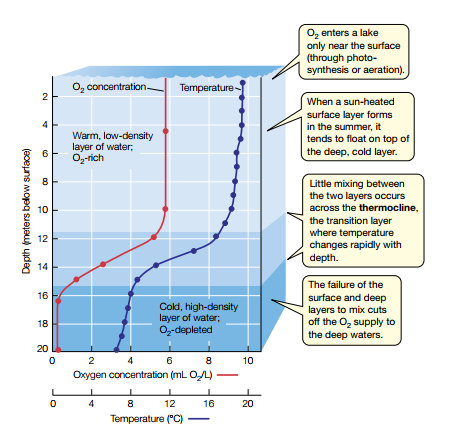O, enters a lake only near the surface (through photo- synthesis or aeration). O, concentration- Temperature- 2 When a sun-heated Warm, low-density layer of water; O-rich surface layer forms in the summer, it tends to float on top of the deep, cold layer. 8. Little mixing between the two layers occurs across the thermocline, the transition layer where temperature changes rapidly with depth. 10 12 14 The failure of the 16 Cold, high-density layer of water; O,-depleted surface and deep layers to mix cuts off the O, supply to the deep waters. 18 20 2 6 8 10 Oxygen concentration (mL OL) – 4 8 12 16 20 Temperature ("C) ) - Depth (meters below surface)
O, enters a lake only near the surface (through photo- synthesis or aeration). O, concentration- Temperature- 2 When a sun-heated Warm, low-density layer of water; O-rich surface layer forms in the summer, it tends to float on top of the deep, cold layer. 8. Little mixing between the two layers occurs across the thermocline, the transition layer where temperature changes rapidly with depth. 10 12 14 The failure of the 16 Cold, high-density layer of water; O,-depleted surface and deep layers to mix cuts off the O, supply to the deep waters. 18 20 2 6 8 10 Oxygen concentration (mL OL) – 4 8 12 16 20 Temperature ("C) ) - Depth (meters below surface)
Chapter12: Water Requirements For Aquaculture
Section: Chapter Questions
Problem 24SA
Related questions
Question
Figure 1.16 seems at first to be simply a description of the
physical and chemical properties of a lake. Outline how living
organisms participate in determining the physical and chemical
(i.e., temperature and O2) patterns. Consider organisms living
both in the lake and on the land surrounding the lake. Consider
also a research report that shows that dense populations of algae
sometimes change the temperature structure of lakes by raising
the thermocline and thereby increasing the thickness of the deep,
cold layer; how could algal populations do this, and what could
be the consequences for deep-water animals?

Transcribed Image Text:O, enters a lake
only near the surface
(through photo-
synthesis or aeration).
O, concentration-
Temperature-
2
When a sun-heated
Warm, low-density
layer of water;
O-rich
surface layer forms
in the summer, it
tends to float on top of
the deep, cold layer.
8.
Little mixing between
the two layers occurs
across the thermocline,
the transition layer
where temperature
changes rapidly with
depth.
10
12
14
The failure of the
16
Cold, high-density
layer of water;
O,-depleted
surface and deep
layers to mix cuts
off the O, supply to
the deep waters.
18
20
2
6
8
10
Oxygen concentration (mL OL) –
4
8
12
16
20
Temperature ("C)
) -
Depth (meters below surface)
Expert Solution
This question has been solved!
Explore an expertly crafted, step-by-step solution for a thorough understanding of key concepts.
Step by step
Solved in 2 steps

Knowledge Booster
Learn more about
Need a deep-dive on the concept behind this application? Look no further. Learn more about this topic, biology and related others by exploring similar questions and additional content below.Recommended textbooks for you


Biology Today and Tomorrow without Physiology (Mi…
Biology
ISBN:
9781305117396
Author:
Cecie Starr, Christine Evers, Lisa Starr
Publisher:
Cengage Learning


Biology Today and Tomorrow without Physiology (Mi…
Biology
ISBN:
9781305117396
Author:
Cecie Starr, Christine Evers, Lisa Starr
Publisher:
Cengage Learning